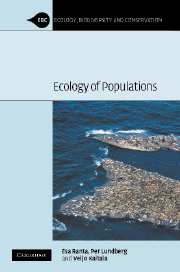Book contents
- Frontmatter
- Contents
- Preface
- 1 Introduction
- 2 Population renewal
- 3 Population dynamics in space – the first step
- 4 Synchronicity
- 5 Order–disorder in space and time
- 6 Structured populations
- 7 Biodiversity and community structure
- 8 Habitat loss
- 9 Population harvesting and management
- 10 Resource matching
- 11 Spatial games
- 12 Evolutionary population dynamics
- 13 Epilogue
- References
- Index
- References
1 - Introduction
Published online by Cambridge University Press: 02 December 2009
- Frontmatter
- Contents
- Preface
- 1 Introduction
- 2 Population renewal
- 3 Population dynamics in space – the first step
- 4 Synchronicity
- 5 Order–disorder in space and time
- 6 Structured populations
- 7 Biodiversity and community structure
- 8 Habitat loss
- 9 Population harvesting and management
- 10 Resource matching
- 11 Spatial games
- 12 Evolutionary population dynamics
- 13 Epilogue
- References
- Index
- References
Summary
… there is nothing so practical as good theory.
Richard FeynmanThe scope of this book is almost as wide as it gets. It touches upon a range of topics in ecology and evolution found in many modern textbooks. Instead of going into considerable depth in any one topic, we have chosen to cover quite a few in order to show that the same basic (and well-known) tools are applicable to a wide variety of ecological and evolutionary problems in population biology. However, this is also a narrow-minded book in the sense that it is very “theoretical,” i.e., full of mathematical expressions and computer simulation results. We believe ecology becomes a healthier science if it appreciates and acknowledges its strong quantitative and more rigorous nature. It is also narrow-minded in the sense that it reflects our own interests in population ecology without attempting to cover all aspects of the ecology of populations. Yet, the scope remains wide and possibly shallow. We believe that ecology and evolutionary biology have to become far more integrated than the fragmented and disparate impression they give today. We think that this can be done by going back to very simple first principles of births and deaths, immigration, and emigration. From those “simple” entities, we can derive virtually everything that plants and animals do in nature. To do so, however, requires a common thread of theory, the seeds of which at least we believe exist. Extensions of that theory will also be dealt with in this book.
- Type
- Chapter
- Information
- Ecology of Populations , pp. 1 - 8Publisher: Cambridge University PressPrint publication year: 2005

